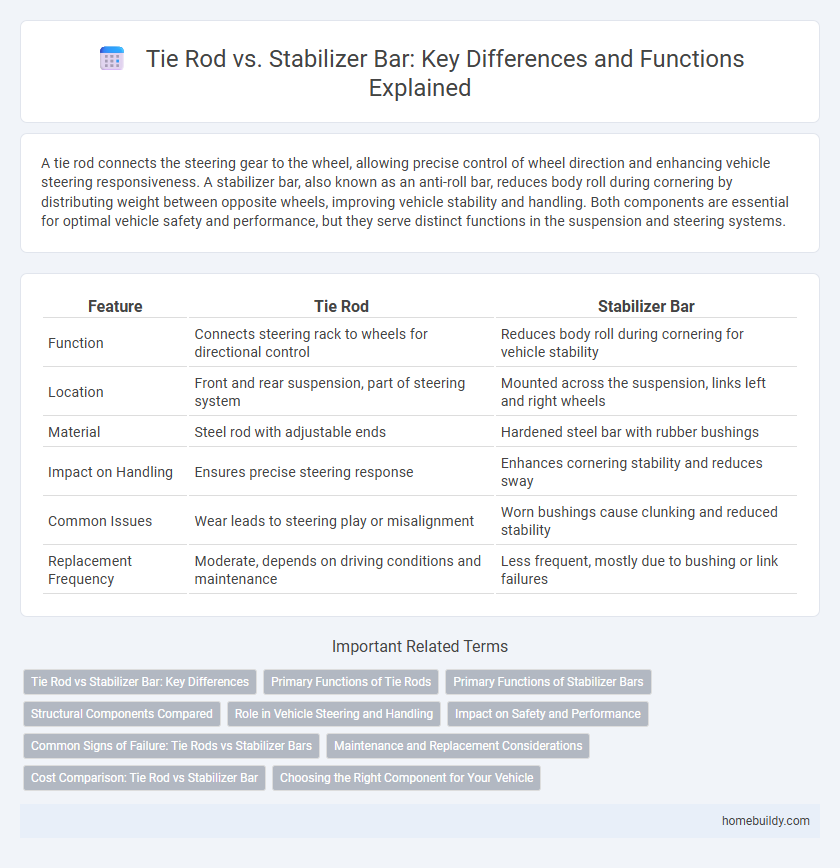A tie rod connects the steering gear to the wheel, allowing precise control of wheel direction and enhancing vehicle steering responsiveness. A stabilizer bar, also known as an anti-roll bar, reduces body roll during cornering by distributing weight between opposite wheels, improving vehicle stability and handling. Both components are essential for optimal vehicle safety and performance, but they serve distinct functions in the suspension and steering systems.
Table of Comparison
| Feature | Tie Rod | Stabilizer Bar |
|---|---|---|
| Function | Connects steering rack to wheels for directional control | Reduces body roll during cornering for vehicle stability |
| Location | Front and rear suspension, part of steering system | Mounted across the suspension, links left and right wheels |
| Material | Steel rod with adjustable ends | Hardened steel bar with rubber bushings |
| Impact on Handling | Ensures precise steering response | Enhances cornering stability and reduces sway |
| Common Issues | Wear leads to steering play or misalignment | Worn bushings cause clunking and reduced stability |
| Replacement Frequency | Moderate, depends on driving conditions and maintenance | Less frequent, mostly due to bushing or link failures |
Tie Rod vs Stabilizer Bar: Key Differences
Tie rods connect the steering rack to the wheel assembly, enabling precise steering control and alignment, while stabilizer bars link the left and right suspension components to reduce body roll during cornering. Tie rods are critical for steering accuracy and vehicle handling, whereas stabilizer bars primarily enhance stability and comfort by minimizing chassis sway. Understanding their distinct functions helps in diagnosing suspension issues and improving overall vehicle performance.
Primary Functions of Tie Rods
Tie rods primarily serve to transmit force from the steering rack to the steering knuckle, enabling precise wheel alignment and steering control in vehicles. Unlike stabilizer bars, which reduce body roll during cornering by connecting opposite wheels, tie rods directly influence the directional movement of the front wheels. Their critical role ensures accurate steering response and maintains vehicle stability during driving maneuvers.
Primary Functions of Stabilizer Bars
Stabilizer bars primarily reduce body roll and improve vehicle stability during cornering by distributing weight more evenly across the suspension. Unlike tie rods that directly control steering angle by connecting the steering rack to the wheels, stabilizer bars link opposite wheels to resist independent suspension movement. Their main function is enhancing handling and safety by minimizing lateral sway, especially on sharp turns or uneven terrain.
Structural Components Compared
Tie rods primarily function as part of the steering system, connecting the steering rack to the wheels and transmitting force to enable directional control, while stabilizer bars (sway bars) serve to reduce body roll by linking the left and right suspension components. Structurally, tie rods consist of a solid metal rod with threaded ends and ball joints for adjustability and flexibility, whereas stabilizer bars are torsion bars made from hardened steel designed to twist and resist lateral vehicle motion. The tie rod's design emphasizes precise movement and alignment, contrasting with the stabilizer bar's role in enhancing vehicle stability and handling by balancing suspension forces across the chassis.
Role in Vehicle Steering and Handling
The tie rod directly connects the steering rack to the wheel, converting steering wheel input into precise wheel movement for accurate vehicle direction. In contrast, the stabilizer bar, or sway bar, reduces body roll during cornering by distributing lateral forces across the suspension system. Together, they enhance steering responsiveness and vehicle stability, with tie rods focusing on directional control and stabilizer bars improving handling balance.
Impact on Safety and Performance
Tie rods directly influence steering precision and alignment, crucial for vehicle safety by ensuring proper wheel direction and minimizing tire wear. Stabilizer bars enhance handling stability by reducing body roll during cornering, improving passenger safety through better control and balance. Together, tie rods and stabilizer bars optimize vehicle performance by maintaining consistent steering response and preventing excessive body movement in various driving conditions.
Common Signs of Failure: Tie Rods vs Stabilizer Bars
Common signs of failure in tie rods include uneven tire wear, steering wheel vibration, and loose or unresponsive steering, often indicating worn ball joints or inner tie rod ends. In contrast, a failing stabilizer bar typically presents as clunking noises when driving over bumps, excessive body roll during turns, and reduced vehicle stability, pointing to damaged bushings or broken links. Identifying these symptoms early helps maintain precise steering control and overall suspension performance.
Maintenance and Replacement Considerations
Tie rod maintenance requires periodic inspection for wear, damage, or bending to ensure precise steering control and vehicle alignment, often involving checking ball joints and tie rod ends for play or corrosion. Stabilizer bars demand routine checks for worn bushings and end links, which can affect handling stability and cause clunking noises under stress. Replacement intervals vary depending on driving conditions, with tie rods typically replaced when steering or tire wear issues arise, while stabilizer bar components are changed when handling issues or excessive sway become evident.
Cost Comparison: Tie Rod vs Stabilizer Bar
Tie rods typically cost between $50 and $150 per unit, making them a more affordable option compared to stabilizer bars, which range from $100 to $300 depending on the vehicle make and model. Labor costs for tie rod replacement average around $100 to $200, while stabilizer bar repairs or replacements can demand $150 to $400 due to increased complexity. Overall, tie rod maintenance presents a lower total expenditure, making it a cost-effective choice for suspension system upkeep.
Choosing the Right Component for Your Vehicle
Choosing between a tie rod and a stabilizer bar depends on your vehicle's steering precision and handling requirements. Tie rods are essential for connecting the steering rack to the wheel, ensuring accurate wheel alignment and responsive steering. Stabilizer bars improve vehicle stability by reducing body roll during cornering, making them crucial for safer handling on uneven or curved roads.
tie rod vs stabilizer bar Infographic

 homebuildy.com
homebuildy.com